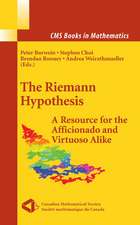Introduction to topological dynamics
Editat de Konstantin Sergeevich Sibirskiien Limba Engleză Paperback – 9 dec 2011
Preț: 380.84 lei
Nou
Puncte Express: 571
Preț estimativ în valută:
72.88€ • 79.14$ • 61.22£
72.88€ • 79.14$ • 61.22£
Carte tipărită la comandă
Livrare economică 22 aprilie-06 mai
Preluare comenzi: 021 569.72.76
Specificații
ISBN-13: 9789401023108
ISBN-10: 9401023107
Pagini: 176
Ilustrații: X, 164 p.
Dimensiuni: 152 x 229 x 9 mm
Greutate: 0.25 kg
Ediția:Softcover reprint of the original 1st ed. 1975
Editura: SPRINGER NETHERLANDS
Colecția Springer
Locul publicării:Dordrecht, Netherlands
ISBN-10: 9401023107
Pagini: 176
Ilustrații: X, 164 p.
Dimensiuni: 152 x 229 x 9 mm
Greutate: 0.25 kg
Ediția:Softcover reprint of the original 1st ed. 1975
Editura: SPRINGER NETHERLANDS
Colecția Springer
Locul publicării:Dordrecht, Netherlands
Public țintă
ResearchCuprins
I. General properties of dynamical systems.- § 1. General definition of a dynamical system.- § 2. Simplest properties of dynamical systems.- § 3. The classification of motions and trajectories.- § 4. Invariant sets.- § 5. Theorems on rest points.- § 6. Dynamical systems on the real line. The isomorphism of dynamical systems.- II. Limiting properties of dynamical systems.- § 7. Dynamical limit points. Properties of limit sets.- § 8. Lagrange stability.- § 9. The classification of motions according to the properties of dynamical limit sets.- § 10. Examples of Poisson stable motions on the torus.- § 11. Properties of Poisson stable points and motions.- III. Nonwandering points. Central motions.- § 12. Wandering and nonwandering points.- § 13. Properties of the set of nonwandering points.- § 14. The set of central motions.- § 15. Minimal center of attraction.- IV. Minimal sets and recurrent motions.- § 16. Minimal sets.- § 17. Almost recurrent motions and recurrent motions.- § 18. Interrelationships among minimal sets, almost recurrent motions; and recurrent motions.- § 19. The Shcherbakov classification of Poisson stable motions. Pseudorecurrent motions.- § 20. The Bebutov dynamical system.- V. Almost periodic motions. Lyapunov stability.- § 21. Uniformly Poisson stable motions and almost periodic motions.- § 22. Lyapunov stability.- § 23. Lyapunov stable motions on the real line.- § 24. Interrelationship between periodicity and Lyapunov stability.- § 25. Motions in dynamical limit sets.- § 26. Stability of rest points.- VI. Generalized theory of dynamical systems.- § 27. General dynamical systems. Topological transformation groups.- § 28. Discrete dynamical systems.- § 29. Partially ordered dynamical systems.- § 30. Dispersive dynamicalsystems.- Literature.











